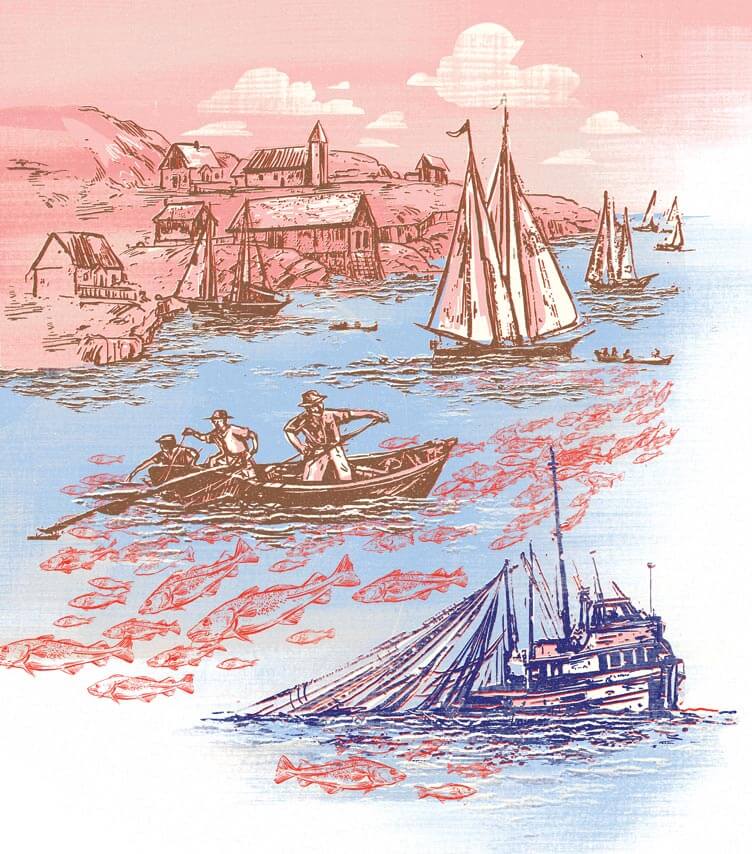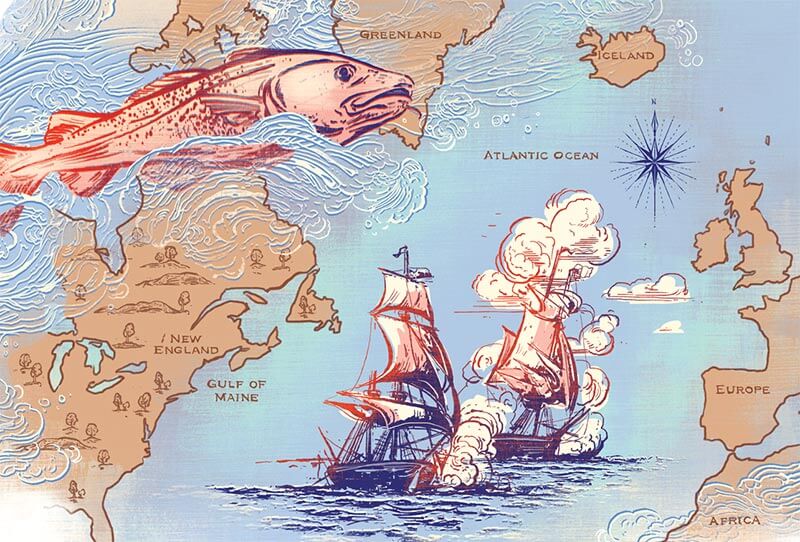- July 28, 2021
- By Liam Farrell
It was there at the tentative beginnings of European voyages to the New World, traveling alongside the wooden cargo ships and, once caught and dried in the cool salt air, fueling the crews that skirted the edges of the earth.
It was there when Leif Erikson set off more than 1,000 years ago for Greenland. He became lost in the churning waters of the North Atlantic, and when he finally came upon land—somewhere near Canada’s Gulf of St. Lawrence, historians believe—it confounded his expectations. He saw fields of wheat, luscious vines sprouting grapes and maple trees of enormous size.
But while divine providence was assumed to have played a role in the safe return of “Leif the Lucky” from what was thereafter known to his people as Vinland, there was a humbler reason for his survival as well—one that would keep swimming through history’s tides.
 This is a story about a fish. Not in the sense of, say, a tangerine clownfish swimming into forbidding open ocean to search for his abducted son; nor in the sense of an old man battling for days off the coast of Cuba with a marlin hooked to the end of his line, or the lies of a fabulist friend about an early morning on a lake. This story is about a fish that has lived in giant schools off North Atlantic shores and, through historical ubiquity and gastronomic utility, supplied ancient explorers, helped build world powers, and lately become a flashpoint between modern science and modern fishermen over how to shepherd its now-struggling population.
This is a story about a fish. Not in the sense of, say, a tangerine clownfish swimming into forbidding open ocean to search for his abducted son; nor in the sense of an old man battling for days off the coast of Cuba with a marlin hooked to the end of his line, or the lies of a fabulist friend about an early morning on a lake. This story is about a fish that has lived in giant schools off North Atlantic shores and, through historical ubiquity and gastronomic utility, supplied ancient explorers, helped build world powers, and lately become a flashpoint between modern science and modern fishermen over how to shepherd its now-struggling population.
And while the importance of the North Atlantic codfish, from its explosive colonial economic impact to its devastation from overfishing in the 20th century, has been explored in academic papers, books and documentaries, a new project led by a University of Maryland researcher aims to see what new lessons can be pried out of bones—specifically, by examining cod bones dug out from places the fish has been eaten, processed or prepared for sale over hundreds of years. George Hambrecht, associate professor and director of undergraduate studies in the Department of Anthropology, is heading a team including researchers from Alaska and Iceland on the initiative, funded by a $1.7 million grant from the National Science Foundation, to use cutting-edge analysis on bones dating from the ninth to the 19th centuries and dug from archaeological sites in Iceland and the Faroe Islands over the last 30 years. In essence, they are making the cod the protagonist of its own environmental story.
“We have the human side, the cod side and the climate side,” Hambrecht says. “We are putting more emphasis on the cod side.”
Prized for its white flesh, low fat and high protein, Gadus morhua is a voracious, omnivorous eater whose territory stretches from America’s Gulf of Maine to the Grand Banks of Newfoundland and onward past the shores of Iceland into the North and Baltic seas. It can live for 20 years, grow longer than four feet and approach 80 pounds. Living in the cold, close to the ocean floor, the cod have had such a high spawning rate that Alexandre Dumas speculated 150 years ago that “it would take only three years to fill the sea so that you could walk across the Atlantic dryshod on the backs of cod.”
 The project’s end result, says Hambrecht, an expert in zooarchaeology, will be an updated 1,000-year history that will not only deepen our understanding of how humans have historically interacted with a critical species, but also provide information that could guide decisions on managing waters and fisheries confronting a rapidly changing environment.
The project’s end result, says Hambrecht, an expert in zooarchaeology, will be an updated 1,000-year history that will not only deepen our understanding of how humans have historically interacted with a critical species, but also provide information that could guide decisions on managing waters and fisheries confronting a rapidly changing environment.
“We’re doing this in part because we’re all sort of history geeks,” Hambrecht says. “But we’re also doing it because there is a good chance historical data can be mobilized to deal with issues coming out of climate change.”
One place where such new knowledge could be put to use is New England, where the fish had near mythical importance for generations of European settlers—it was the source for the name of Massachusetts’ cape, was on the seal of the court that held the Salem witch trials, and formed the basis of a Daniel Webster speech in the U.S. Senate about the benefits of chowder. In one regional folk telling spun from the Bible story, the fish’s telltale white stripe extending from head to tail came from when Jesus handed it out along with bread loaves to feed the masses.
It wasn’t just “cod;” it was the “sacred cod.”
 When John Adams traveled to Paris as part of the team negotiating the end of the Revolutionary War, he carried the interests of fishermen with him.
When John Adams traveled to Paris as part of the team negotiating the end of the Revolutionary War, he carried the interests of fishermen with him.
By the latter half of the 18th century, cod had become one of the most important commodities in the British colonies, particularly for New England and Adams’ native Massachusetts. Dried and salted cod was the fourth-most valuable export, trailing only sugar, tobacco and grain, and New England fisheries processed more than 39 million pounds of it in 1765.
The cod trade also played a significant role in the growing economic—and political—independence of what would become the United States. In addition to sending cod to Britain, a lower-grade product was also shipped to feed enslaved people on sugar plantations in the West Indies in exchange for the molasses needed to manufacture rum. Adam Smith, in his seminal “The Wealth of Nations,” praised the money brought in by American fisheries as an example of the prosperity fostered by untrammeled free trade.
And as the mother country began to wield a stronger hand in both taxation and commerce, Adams thought the restraints put on fishing and fishermen were “sundering this country from (Britain), I think, forever.” The sometimes literal fights over such fishing laws, he believed, would eventually achieve greater infamy than the Boston Massacre.
Adams’ success in maintaining American access to the fertile cod grounds of Canada as part of the Treaty of Paris was, then, a prime political achievement—particularly after the members of what was essentially the first United States Navy had so successfully shifted those same cod trades from molasses to ammunition.
For “how could we restrain our fishermen, the boldest men alive,” Adams once asked, “from fishing in prohibited places?”
George Hambrecht doesn’t mind harsh weather. For him, the North Atlantic, with its sharp winds, dramatic waves and rocky shores, feels less like the end of the world than the start of an entirely different one to explore.
He grew up in San Francisco (“I love fog,” he says) and earned a degree in history from Bard College in 1995 but didn’t take a single anthropology or archaeology course while at the Hudson River school. He speculates now that a bout with what was likely cholera on a high school trip to Mexico’s Yucatan Peninsula partially soured him on the prospect. Hambrecht also didn’t immediately go to graduate school after completing his bachelor’s degree; he returned to California and worked in the wine business until he came around to the notion of combining his enjoyment of the natural world with his interest in studying the past.
“I loved working outside and being in dirt. I didn’t want to be stuck in an archive or a library,” he says. “Dirt plus history equals archaeology.”
So Hambrecht went to the Graduate Center of the City University of New York and embarked on a career that has included excavations on everything from an 18th-century colonial estate in Barbuda to the hidden yellow fever burial grounds of Washington Square Park in New York City, before coming to the University of Maryland in 2011.
One of his longest-running professional fascinations has focused on Iceland. For almost 20 years, Hambrecht’s been working amid a landscape of volcanoes and glaciers, one of the last places on Earth colonized by humans. In particular, he’s been digging at a bishop’s farm at Skálholt for centuries-old bones of sheep, cattle and—yes—cod.
With isotope analysis, Hambrecht says, researchers can glean incredible amounts of scientific detail from a bone. By cataloguing levels of chemical elements like carbon, nitrogen, oxygen and sulfur, it’s possible to figure out where an animal was born, what kind of environment it lived in, and where it died.
“You are what you eat, drink and breathe,” Hambrecht says. “All of us are basically sponges, sampling the environment around us at all times.”
But he also sees animal bones as an artifact like a sword hilt, statue or stone foundation, a clue to the framework of past human life and how our ancient ancestors coexisted with animals.
“There’s a huge amount we can tell about subsistence, diet, way of life,” he says, “everything from what (people) ate to ideas of the afterlife.”
And in the places that the cod trade built, people soaked up more than just traces of chemicals from food, water and air. In the intertwined relationship between human and animal, they also built an entire culture wrapped around the fortunes of a fish.
About 30 miles northeast from a cod sculpture hanging in the Boston statehouse, Gloucester fisherman Al Cottone does his best not to catch any of the fish that once created his state’s foundational merchant class and strengthened a burgeoning independent spirit.
The son of Sicilian immigrants, Cottone started regularly working on the water with his father as a teenager and is still a full-time fisherman in addition to holding side duties as executive director of the city’s fisheries commission. While even 10 years ago his seasonal cod quota was 35,000 pounds, it’s now down to 1,800—a result of restrictions meant to revive the fish population after its collapse in the 1990s. Now when he sets off in his 40-foot boat, he’s looking for haddock or flounder.
“We call it the Cod Avoidance Program,” he says. “I’ve caught more than that (cod quota) in five minutes.”
Cottone and his fellow fishermen are frustrated by the limits; they are convinced the stock assessment surveys and methods used by the National Oceanic and Atmospheric Administration underestimate the amount of cod they see every day in the water, but NOAA has already declared that a decade-long plan to rebuild the New England cod stocks won’t meet its 2024 target.
And even if cod quotas were voluminously increased overnight, it’s questionable whether Gloucester, a town with an 8-foot-tall dockside bronze statue memorializing fishermen who died at sea, still has the infrastructure to bounce back to its storied past. Hemmed in by catch limits and a flood of imported fish, Cottone estimates, Gloucester has lost as much as 90% of the boats that were there in the 1980s, creating a domino effect on everyone from dock workers to ice sellers. At age 55, he believes he’s probably the average for a graying workforce, and is trying to brainstorm ways to pass on fishing skills to younger generations before it’s too late.
“We need to keep what we have going,” Cottone says. “Every boat we lose, every captain we lose, we’re losing the heritage and experience that could be passed on.”
The spark for the Atlantic cod project was research conducted in the Pacific Ocean.
Through a grapevine of professional organizations, Hambrecht came across the work of Nicole Misarti, a research associate professor and director of the Water and Environmental Research Center at the University of Alaska Fairbanks. Misarti had been combing through everything from isotopes to hormones in bones and trace elements in teeth to examine the Pacific walrus over several thousand years.
It’s been a productive exercise. In walrus teeth, Misarti’s team discovered multiple spikes of elements associated with petroleum exploration, air pollution and sea ice melt during the latter half of the 20th century. The group also found that walrus have a more varied diet during periods of low sea ice, likely due to difficulty in accessing preferred hunting grounds; the modern walrus, however, has become more reliant on invertebrates than its ancestors, and less likely to eat seals or birds. And similar levels of cortisol—the so-called “stress hormone”—between modern and ancient walruses may indicate physiological resilience in the face of increasing pressure from climate change.
The pair thought that turning those techniques to an animal with a much more extensively documented historical tie to humans—“(We) look at both species as a partnership,” Hambrecht says—would be fruitful.
So using samples that have already been excavated and are held in labs from Maryland to Norway by members of a scholarly cooperative called the North Atlantic Biocultural Organisation, the researchers will analyze bone slices and powder not just for details on a particular fish itself, but for clues they can provide about population-level genetic changes and ecological shifts over time such as ocean temperature and acidification, as well as how the species fit into the wider food web.
“What changes occurred in this fish stock in particular, and how did that affect the humans that were relying on them?” says Misarti, who is also a principal investigator on the project. “There’s not a lot of other fish stocks that have the written history to go along with the archaeological history that can give us a 1,000-year picture of what’s going on.”
Their ambition is to create a new starting point for proposed solutions to climate change and overfishing. Maybe more answers can be found, Hambrecht says, if our idea of what is “normal” shifts from taking into account just the past century or so and instead moves “that baseline back.” Archaeology is ultimately not predictive, but gathering centuries of data on the cod and its fluctuating relationship to humanity and the environment may provide clues on how to better support a species that has played a crucial role in geographical, economic and cultural development, and is now facing unprecedented ecological change.
“We’re never going to find an exact parallel to what is happening now,” Hambrecht says. “But we at least think we can broaden our ideas of what is possible.”
Topics
Research